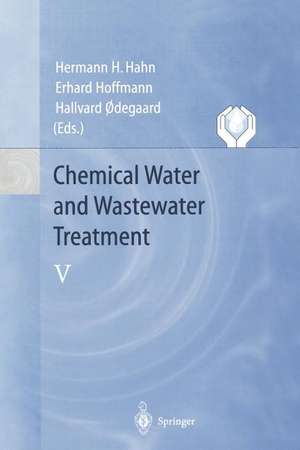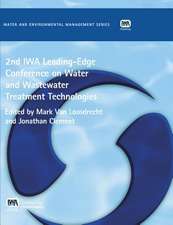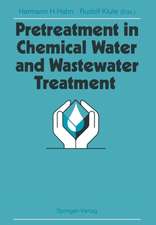Chemical Water and Wastewater Treatment V: Proceedings of the 8th Gothenburg Symposium 1998 September 07–09, 1998 Prague, Czech Republic
Editat de Hermann H. Hahn, Erhard Hoffmann, Hallvard Odegaarden Limba Engleză Paperback – 8 dec 2011
Preț: 647.08 lei
Preț vechi: 761.27 lei
-15% Nou
Puncte Express: 971
Preț estimativ în valută:
123.81€ • 129.29$ • 102.24£
123.81€ • 129.29$ • 102.24£
Carte tipărită la comandă
Livrare economică 15-29 aprilie
Preluare comenzi: 021 569.72.76
Specificații
ISBN-13: 9783642722813
ISBN-10: 3642722814
Pagini: 432
Ilustrații: XII, 414 p.
Dimensiuni: 155 x 235 x 23 mm
Greutate: 0.6 kg
Ediția:Softcover reprint of the original 1st ed. 1998
Editura: Springer Berlin, Heidelberg
Colecția Springer
Locul publicării:Berlin, Heidelberg, Germany
ISBN-10: 3642722814
Pagini: 432
Ilustrații: XII, 414 p.
Dimensiuni: 155 x 235 x 23 mm
Greutate: 0.6 kg
Ediția:Softcover reprint of the original 1st ed. 1998
Editura: Springer Berlin, Heidelberg
Colecția Springer
Locul publicării:Berlin, Heidelberg, Germany
Public țintă
ResearchDescriere
It was intended to return with the International Gothenburg Symposia every other time to the birthplace of these events, Gothenburg in Sweden. But instead the 8th symposium has been invited to be organized and held in Prague, i. e. in the midst of Central and Eastern Europe a region now keen on intensified environmental control. This attests that the symposia have attained such standing in the interna tional world of operators, designers, officers and researchers in water treatment technology that their presence in various parts of the world has been requested. And this ever growing significance, in short the success of this conference series, stems form the fact that the symposia offer a unique platform for the exchange of ideas and experiences on all aspects of water and wastewater treatment between administrators, engineers and scientists. The content of this book, i. e. the schedule of the symposium lectures, results for the most part from a vast response to an international call for papers. Many excellent contributions are included in this volume but at the same time many outstanding ones could not be included for lack of time and space. The total sum of these contributions document again the development in the field, both in terms of new technological (and other) developments as well as public and administrative acceptance and approval of solutions offered.
Cuprins
Chemicals for Coagulation/Precipitation.- Application of Polysilicato-Iron Coagulant to Coagulation of Algae and Municipal Wastewater.- Evaluation of Poly-Alumino-Iron Sulphate (PAFS) as a Coagulant for Water Treatment.- Composite Inorganic Polymer Flocculants.- Chemicals for Oxidation/Disinfection.- Stable Intermediates in the Photooxidative Treatment of Synthetic Groundwaters Containing Benzene.- Ferric Nitrate Dosing at Morecambe WwTW for Sulphide Control.- A Comparison of the Effects of Different Oxidants/Disinfectants on Biologically Active Drinking Water Filters.- Coagulation and Floc Separation.- Automatic Determination of Coagulation-Flocculation Reagents Dose.- Flocculation Modelling of Primary Sewage Effluent.- Density and Strength of Deposits Formed During In-line Flocculation Filtration of Secondary Effluents.- Drinking Water Treatment.- Enhanced Versus Optimized Multiple Objective Coagulation.- Chemical Addition Prior to Membrane Processes for Natural Organic Matter (NOM) Removal.- Adding Particles to Remove Turbidity and Organics with High Rate Chemical Treatment.- The Use of Polymers in Water and Wastewater Treatment.- The Use of Polymers in Wastewater Treatment — Report on a (German) ATV Manual.- Cationic Polymers and Their Complexes in Wastewater Treatment.- The Use of Cationic Polymers as Primary Coagulants in Water Treatment.- Enhanced Particle Separation in Primary Treatment.- Enhanced Primary Treatment in Floating Filters.- Effect of Floc Characteristics on High Rate Filtration of Sewage.- Primary Effluent Filtration for Coastal Discharges.- Combined Biofilm and Chemical Wastewater Treatment.- The Mass Balances of Nitrogen and Carbon in a Compact Nitrogen and Phosphorus WWTP.- Options for Phosphorus Removal on Trickling Filter Plants.- Upgrading the Chemical Precipitation Process Using a Fixed Film Biological Reactor: A Case Study of the Taskila Plant of Oulu, Finland.- Optimisation of Floc Characteristics for Separation.- Rapid Determination of Bacterial Assemblage Structure: Implications to Process Optimisation in Wastewater Treatment.- Influence of Surface Charge and Exopolysaccharides on the Conditioning Characteristics of Sewage Sludge.- Fundamental Methods for Optimizing Residuals Dewatering.- Sludge Treatment and Resources Reuse.- Exergy Analysis: A Comparison of Various Treatment Alternatives for Nutrient Removal.- Recovery of Valuable Products from Municipal Wastewater Sludge.- ATHOS: A Novel Process for Sludge Disposal.- Identification and Evaluation of Wastewater Scenarios, Based on Physical-Chemical Pretreatment.- Case Studies — Wastewater Treatment.- Increased Efficiency of Chemical Treatment to Meet New Demands for Ocean Discharge in San Diego.- Low Dose Chemical Pretreatment and Its Implication on Biological Treatment Plants.- Case Studies — Drinking Water Treatment.- Chemical Treatment of Surface Water for Groundwater Replenishment in Jungfernheide, Berlin.- Case Study: Faure Water Treatment Plant Potable Water Treatment and Sludge Handling.- Author Index.
Caracteristici
Current practice-oriented problems of the water and wastewater treatment
Segment: Environmental Sciences
Segment: Environmental Sciences




















